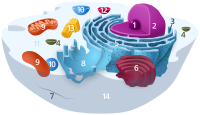
Photo from wikipedia
Research published in The Journal of Immunology reveals an unexpected role for B cell activating factor (BAFF, also known as TNF super family member 13B) in the formation of tertiary… Click to show full abstract
Research published in The Journal of Immunology reveals an unexpected role for B cell activating factor (BAFF, also known as TNF super family member 13B) in the formation of tertiary lymphoid structures (TLSs) in the kidneys of lupus-prone mice. “Although the presence of TLSs in non-lymphoid organs such as the kidneys has been reported, what causes their formation has remained unknown,” explains Barbara Vilen, corresponding author on the study. “We defined a novel role for BAFF in the formation of TLSs and in the positioning of T cells during lupus nephritis,” she states. BAFF levels are raised in patients with systemic lupus erythematosus and anti-BAFF therapy has shown promise in clinical trials. “Past studies mainly implicated BAFF in breaking B cell tolerance by allowing autoreactive B cells to compete for follicular niches, but several things remained unknown,” says Vilen. “First, what causes increased BAFF production during disease, and second, does BAFF play a role in lupus nephritis?” After passive transfer of antinucleosome antibodies into lupusprone AID–/– MRL/lpr mice (which lack IgG and do not spontaneously develop lupus nephritis), Vilen and colleagues saw an increase in the migration of immune cells into the kidneys, which was coordinated by the binding of immune complexes to Fcγ receptors. The number of TLSs in the kidneys increased sixfold, and the number of BAFF-producing cells in the kidneys increased threefold in mice injected with antinucleosome antibodies as compared with those injected with saline. Reducing BAFF levels by administration of soluble BAFF receptor to lupus-prone mice reduced serum levels of autoantibodies, prevented the development of renal TLSs and limited nephritis, although it did not reduce the infiltration of immune cells into the kidney. Intriguingly, reducing BAFF levels in these mice caused T cells in the kidney to be positioned outside of the glomeruli. “How BAFF does this remains unclear since BAFF is not a chemoattractant,” states Vilen. “However, taken together, our study mechanistically links immune complexes, Fcγ receptors and BAFF in lupus nephritis, and in the formation of renal TLSs,” she concludes. Joanna Collison L U P U S N E P H R I T I S
Journal Title: Nature Reviews Rheumatology
Year Published: 2017
Link to full text (if available)
Share on Social Media: Sign Up to like & get
recommendations!